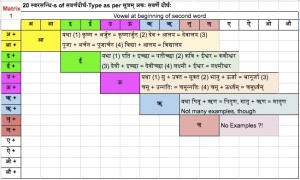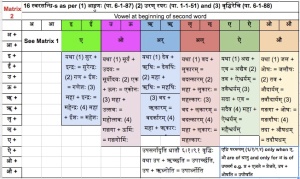Lesson 21
Simple Sanskrit – Lesson 21
सरलं संस्कृतम् – एकविंशतितमः पाठः |
Even though I have been discussing स्वरसंधि-s in previous lessons, it has always been on my mind that there should be a structured, tabulated view, sort of a Matrix view. After quite some effort and study, I am glad that I have been able to compile primarily the general rules for all the 196 possible combinations of स्वरसंधि-s in just 4 matrices.
I would like to present them across three lessons matrices 1 and 2 in this lesson 21, Matrix 3 in next lesson No. 22 and Matrix 4 in lesson No. 23.
Here is Matrix 1 covering स्वरसंधि-s as per सूत्रम् – अकः सवर्णे दीर्घः (6-1-101). Examples of all 20 स्वरसंधि-s are also given.
- Note, just one सूत्रम् with just three words becomes the rule covering 20 स्वरसंधि-s ! That is पाणिनि !!
These संधि-s are also called as सवर्णदीर्घसंधि-s. These are 5 blocks, of 4 संधि-s each, diagonally across 10 rows.
To proceed further, it becomes logical to proceed by rows, firstly by the first two rows for अ + and आ +.
Here is the matrix 2 for the first two rows.
As can be seen, in Matrix 2,
-
There are 8 संधि-s under columns for इ, ई, उ, ऊ. These are as per पाणिनिसूत्रम् आद्गुणः (6-1-87). संधि-s as per this rule are also called as गुणसंधि-s.
-
Next there are 8 more under columns for ऋ, ॠ, लृ, ॡ as per उरण् रपरः (1-1-51).
-
Further there are 8 more under columns for ए, ऐ, ओ, औ. These are as per वृद्धिरेचि (६/१/८८). संधि-s as per this rule are also called as वृद्धिसंधि-s
I would think that explaining the rules and patterns, by explaining the पाणिनिसूत्र-s would eminently be beyond the scope of “Simple Sanskrit”. But in case of संधि-rules in particular,
-
It is interesting how a short and crisp सूत्रम् specifies the rule for so many patterns.
-
one needs to also know special cases, when a particular rule is superseded by another subsequent rule. There is a सूत्रम् even to say that, when applicable, a subsequent सूत्रम् supersedes a previous सूत्रम् !! For those interested, the सूत्रम् is विप्रतिषेधे परं कार्यम् (१-४-२)
In this matrix 2
-
There is a box under the columns for ऋ, ॠ, लृ and ॡ, mentioning the सूत्रम् – उपसर्गादृति धातौ (6-1-91). This सूत्रम् supersedes the सूत्रम् उरण् रपरः (1-1-51) applicable for these columns. Hence, by virtue of this superseding सूत्रम्, in the special cases of अ/आ-ending उपसर्ग-s followed by धातु-s having initial वर्ण ऋ, there is वृद्धिः आर् instead of अर्. Note संधि between उपसर्ग and धातु is compulsory.
-
There is also another box under the columns for ए, ऐ, ओ, औ, noting सूत्रम् – एङि पररूपम् (६/१/९४) Sanskrit-explanation of this is अवर्णान्तात् उपसर्गात् एङादौ धातौ परतः पूर्वपरयोः स्थाने पररूपमेकादेशः भवति, संहितायां विषये, meaning if अ-ending उपसर्ग is followed by धातु-s having initial वर्ण ए or ओ, then
-
such संधि of अ + ए does not become ऐ it becomes ए only, e.g. प्र + एजते (प्र् + {अ + ए} + जते = प्र् + {ए} + जते) = प्रेजते
-
likewise संधि of अ + ओ does not become औ, it becomes ओ only, e.g. उप + ओषति (उप् + {अ + ओ} + षति = उप् + {ओ} + षति) = उपोषति
-
The box applies only for columns for ए and ओ, not for all the 4 columns. So, these are very special संधि-s of अ + ए and अ + ओ.
-
Such संधि-s are also called as पररूपसंधि-s
-
It is important to bear in mind the rule, telling the instances, when it is compulsory to make a संधि.
संहितैकपदे नित्या नित्या धातूपसर्गयोः |
नित्या समासे वाक्ये तु सा विवक्षामपेक्षते ||
By पदच्छेद,
-
संहिता एकपदे नित्या
-
नित्या धातु-उपसर्गयोः
-
नित्या समासे
-
वाक्ये तु सा विवक्षां अपेक्षते
संहिता नित्या = संहिता i.e. संधि (is to be done) नित्या, always = it is compulsory to make a संधि
-
एकपदे = The resultant word is to be used as one word only, e.g. कश्चित् Actually the word is a संधि of कः + चित्
-
धातूपसर्गयोः = Between धातु and उपसर्ग, e.g. in अपेक्षते there is उपसर्ग अप and धातु ईक्षते These have to be said only as अपेक्षते as per the गुणसंधि of अ + ई = ए See column for ई in Matrix 2.
-
समासे = The word धातूपसर्गयोः is a compound word having component words धातु and उपसर्ग. Because it is a compound word, there has to be संधि of उ + उ = ऊ, a सवर्णदीर्घसंधि as per अकः सवर्णे दीर्घः in Matrix 1.
वाक्ये तु सा विवक्षां अपेक्षते = In a sentence it is discretionary. For example, one may say त्वं एव माता or त्वमेव माता.
We shall see Matrix 3 in the next lesson.
शुभं भवतु |
-o-O-o-

